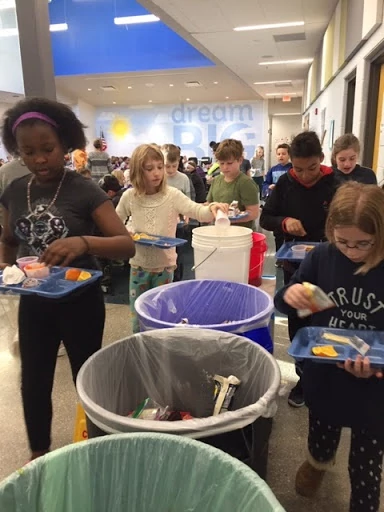EDUCATION
Center for Green Schools
By Michelle Carpenter, Shaw Contract Director of Education, and Anisa Heming, Director, Center for Green Schools at USGBC
SUSTAINABILITY IN LEARNING TODAY
School buildings and sites, which cover 2 million acres of land and operate over 7.5 billion gross square feet of building area, are responsible for significant carbon emissions in the U.S. Carbon emissions from schools come from several sources, including building energy use, grounds management practices, and transportation to and from school. If U.S. schools collectively reduced just 5 percent of their overall energy use, the savings would equate to around 10.1 million metric tons of CO2e per year. This energy reduction would be equivalent to adding 2,130 wind turbines to our U.S. electricity grids for the year.

In addition to the environmental benefits that can come from working directly with students to reduce carbon emissions at their schools, the proposed effort will harness the power that students have as catalysts within their communities. When we educate and equip students to lead, they are more likely to become ambassadors of social and environmental responsibility, educating their families and broader communities about the value of environmental stewardship. Studies have found that students exposed to environmental education indirectly influence their parents’ behavior positively as related to recycling and conservation of resources at home. Furthermore, a Stanford University review of 119 studies measuring the impact of environmental education found clear evidence that it builds emotional and social skills, improves environmentally friendly behavior, and increases civic interest and ability to take action. Students can take the learning and success of their carbon emissions reduction efforts community-wide, and by inviting the surrounding community to support and be part of the process, their schools can become a source of local pride that we can all benefit from.
BUILDING LEARNERS
The U.S. Green Building Council offers a new program for K–12 schools that incorporates building data into the classroom like never before. The Building Learners program equips schools with curriculum, training, a volunteer mentor and the Arc building performance platform. With guidance and tools, school teams are empowered to engage students in real-world, hands-on learning about sustainability performance and its connection to their studies, future careers, and local and global communities.
The Building Learners program is a complete, data-driven package that uses your school’s eco footprint to bring lessons to life. Students sharpen their analysis and problem-solving skills while observing the benefits of their impact on the school’s sustainability performance. Students also gain exposure to sustainability careers and build positive relationships with members of their community.
The core Building Learners team consists of three individuals: a green building professional to serve as a volunteer mentor, an educator, and a school facilities staff member. Mentors provide valuable, real-world insight and guidance and have an immediate impact on students as they learn about the possibilities for sustainability improvement at their school.
"We know that educators are looking for real-world challenges to engage their students in hands-on learning, and we know that more and more school facilities leaders are recognizing the need to improve the environmental sustainability of their buildings,” says Anisa Heming, director of the Center for Green Schools. “This program brings all the pieces together to get students excited about grading their school’s ‘ecofootprint’ and then lowering it through their own actions.”
ARCHITECTURE FOR BUILDING LEARNERS
Building Learners is composed of three core ways to engage students:
1. Using the school as a teaching tool
The green building benchmarking lessons teach students the science behind buildings and sustainability concepts. This equips them with the knowledge and skills to investigate and improve the eco footprint of their school.
2. Track and evaluate real-world data
Students collect and track their school’s water, energy, waste, transportation, and environmental health data using the Arc sustainability management platform. That data informs student-led action projects aimed at improving awareness, policies, and school-community sustainability performance.
3. Receive guided support resources
The green building benchmarking lessons teach students the science behind buildings and sustainability concepts. This equips them with the knowledge and skills to investigate and improve the eco footprint of their school.
BUILDING LEARNERS IN ACTION

Briarwood Elementary | Kansas City, Kansas: A second grade teacher, a local green building professional, and the school district’s sustainability director worked together to design and implement a cafeteria waste audit. The team initiated a food waste reduction campaign that would cut food waste by 25% in one week.
Boston Latin School | Boston, Massachusetts: Through collecting, analyzing, and taking action on their school building data, students at Boston Latin School have acquired leadership abilities and skills they can use in their future careers. They have also influenced their peers and school community to contribute to a more sustainable learning environment.
BENEFITS FOR THOSE WHO ENGAGE IN BUILDING LEARNERS:
- Teachers can engage students without leaving the school building; they receive professional development and learn alongside sustainability industry professionals.
- LEED professionals play a key role in assisting school staff and students in understanding green building science and making classroom-to-career connections. They can learn how to use Arc, as well as earn volunteer hours toward maintaining their LEED credentials.
- School facilities and sustainability staff can make informed decisions about facilities improvements using data, while connecting to the educational program of the school.
- Students work alongside a range of professionals and develop skills in problem solving, critical thinking, creativity and collaboration, while addressing real-world issues that impact their school communities.
GIVING BACK TO THE LEARNING LANDSCAPE

Center for Green School’s Building Learners initiative is supported by Shaw Contract through their partnership product, Cut + Compose, where 1.5% of sales are given back to support the initiative.
This carpet collection was crafted with students in mind. Through the use of letters, numbers, and abstract elements that are cut, rotated, deconstructed and composed, Cut + Compose brings vibrancy to learning environments. This partnership ensures teachers have access to professional development and learning tools that propel sustainability goals to action for themselves and their students. This partnership is one way in which Shaw Contract gives back to the learning community and supports key initiatives that move the learning landscape forward.
YOU CAN HELP BUILD LEARNERS TOO
Do you know of a school that would be a great fit with Building Learners or are interested in being a school mentor? Visit learninglab.usgbc.org/building-learners to learn more and get involved.
February 28, 2020